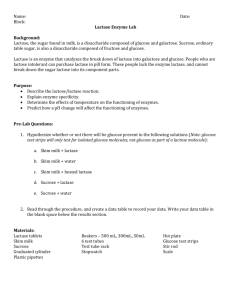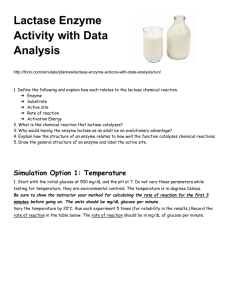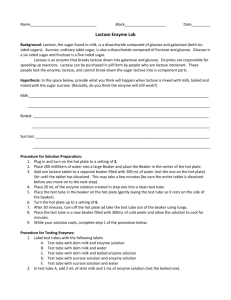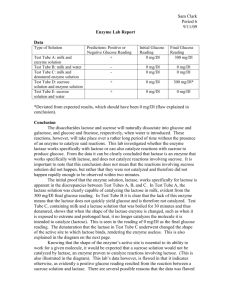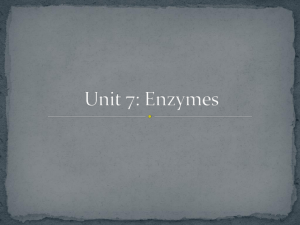Lactase Enzyme Lab: Enzyme Specificity & Denaturing
advertisement
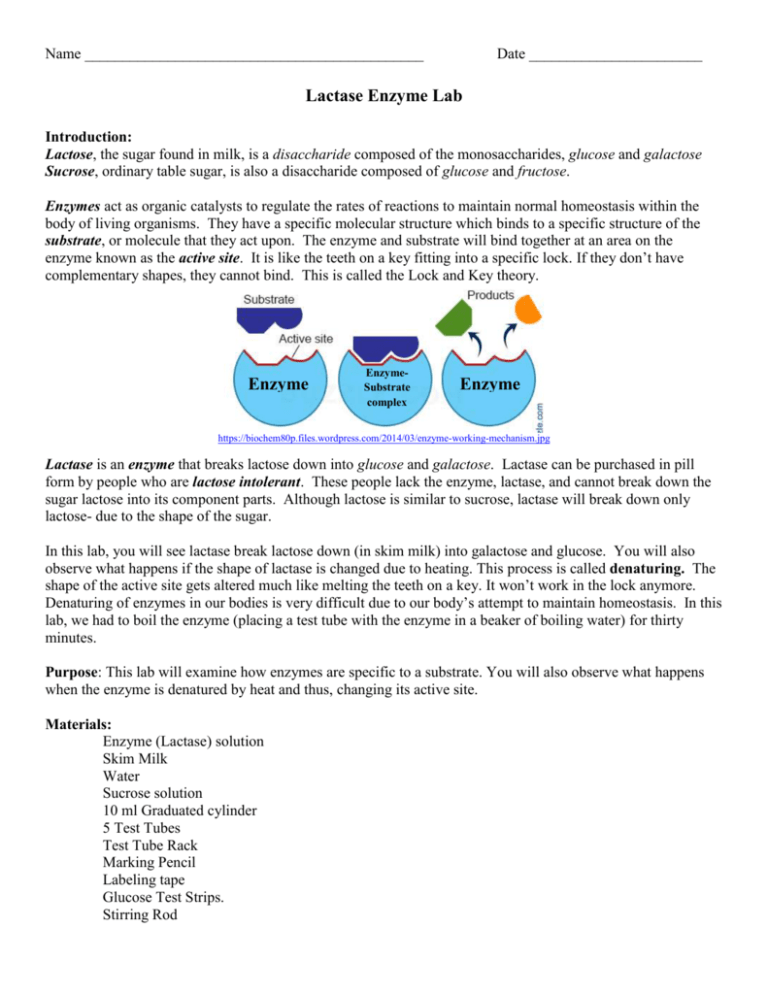
Name _____________________________________________ Date _______________________ Lactase Enzyme Lab Introduction: Lactose, the sugar found in milk, is a disaccharide composed of the monosaccharides, glucose and galactose Sucrose, ordinary table sugar, is also a disaccharide composed of glucose and fructose. Enzymes act as organic catalysts to regulate the rates of reactions to maintain normal homeostasis within the body of living organisms. They have a specific molecular structure which binds to a specific structure of the substrate, or molecule that they act upon. The enzyme and substrate will bind together at an area on the enzyme known as the active site. It is like the teeth on a key fitting into a specific lock. If they don’t have complementary shapes, they cannot bind. This is called the Lock and Key theory. Enzyme EnzymeSubstrate complex Enzyme https://biochem80p.files.wordpress.com/2014/03/enzyme-working-mechanism.jpg Lactase is an enzyme that breaks lactose down into glucose and galactose. Lactase can be purchased in pill form by people who are lactose intolerant. These people lack the enzyme, lactase, and cannot break down the sugar lactose into its component parts. Although lactose is similar to sucrose, lactase will break down only lactose- due to the shape of the sugar. In this lab, you will see lactase break lactose down (in skim milk) into galactose and glucose. You will also observe what happens if the shape of lactase is changed due to heating. This process is called denaturing. The shape of the active site gets altered much like melting the teeth on a key. It won’t work in the lock anymore. Denaturing of enzymes in our bodies is very difficult due to our body’s attempt to maintain homeostasis. In this lab, we had to boil the enzyme (placing a test tube with the enzyme in a beaker of boiling water) for thirty minutes. Purpose: This lab will examine how enzymes are specific to a substrate. You will also observe what happens when the enzyme is denatured by heat and thus, changing its active site. Materials: Enzyme (Lactase) solution Skim Milk Water Sucrose solution 10 ml Graduated cylinder 5 Test Tubes Test Tube Rack Marking Pencil Labeling tape Glucose Test Strips. Stirring Rod Procedures: 1) Put on your goggles and gather your equipment 2) Label the 5 test tubes with the following labels: A. Skim milk + enzyme B. Skim milk + water. C. Skim milk + denatured enzyme D. Sucrose + enzyme E. Sucrose + water. 3) In test tube A, add 2 ml of skim milk and 1 ml of enzyme solution. 4) In test tube B, add 2 ml of skim milk and 1 ml of water. 5) In test tube C, add 2 ml of skim milk and 1 ml of denatured enzyme solution. 6) In test tube D, add 2 ml of the sucrose solution and 1 ml of enzyme solution. 7) In test tube E, add 2 ml of the sucrose solution and 1 ml of water. 8) Now wait 2 minutes after you have filled all the test tubes then test each test tube solution for glucose with the glucose test tape. Glucose test strips are normally a teal color. They will change from teal to green or brown with a higher concentration of glucose. Any change from this teal is a positive result. If there was glucose present, mark a '+' in the table. If glucose was absent, mark a '-' in the table. Record this data in table 1. Table 1: Glucose presence in solutions Glucose test Treatment Strip results Test Tube ( + or -) Skim milk + 1 Enzyme 4 Skim milk + water Skim milk + Boiled enzyme Sucrose + Enzyme 5 Sucrose + water 2 3 Conclusion/Questions: 1. What is an enzyme? 2. What part of the enzyme will bind to the substrate (the molecule it acts upon)? 3. What happened in the lactose and lactase reaction to produce a positive glucose test strip result? 4. Why did the enzyme lactase react to lactose and not to sucrose? 5. What happened to the enzyme when it was boiled? 6. Another way to affect the enzyme is by lowering the pH of the solution. However, lactase is supposed to be able to work in the stomach. Would lowering the pH of the enzyme solution affect the enzyme? Why or why not? 7. What type of reaction is this? Dehydration synthesis or Hydrolysis? Explain your answer.


